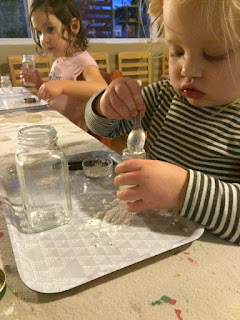A huge motivator for children is learning the qualities of the world around them. They want to know how things work, why things work, and how they can effect it. By offering as many opportunities for children to experiment, ask questions and delve in to the wonderous world and work of inquiry, they guide and shape their own knowledge and continuously absorb what they learn.
One of our favorite ways to to create concoctions. This is a very exciting work for everyone and something that is frequently asked for during the day. The set up is often the same, very orderly and with small tools for mixing, small jars and bowls and various powders and liquids. The opportunities for discoveries are limitless!
Materials:
A tray
Jars
Small Bowls
Tweezers
Pipettes
Measuring Spoons
Small Brushes
Flour
Baking Soda
Corn Starch
Liquid Watercolor
Tissue Paper
Glue
Water
This list of materials really is endless. The idea is that the tray contains any overflow of materials and also sets a boundary of focus for each child. The tools and containers are made from glass, metal and rarely plastic. They are child sized versions of tools adults use. Often we even talk about and pretend we are scientists or artist working or using these tools! The loose materials are given to the children in small amounts and named as they are added to the trays, bowls and jars. Everyone can use what is on their tray as much as they like, but we do not add more. This limit encourages focus on what is available, moving slowly and carefully, and using the materials thoughtfully.

 Once the children are offered the materials, we sit back and observe. Often we sportscast the words, wonderings and observations of the children to concrete what they are noticing.
Once the children are offered the materials, we sit back and observe. Often we sportscast the words, wonderings and observations of the children to concrete what they are noticing.
"It's exploding!"
"I heard you say, 'The cornstarch feels soft.'"
"You noticed the red and blue turned purple!"
Then we extend their explorations:
"It's exploding! I wonder how that happened?"
"Why is cornstarch soft?"
"Where did the purple come from?"
And always :
"What did you notice? What did you wonder?"

Some children remain with this work as long as it available, while others take just a few moments to explore. Each time it is offered, I have noticed that it creates an almost instant opportunity to focus and the children are drawn in to a refinement of movement that feels very satisfying: using tweezers to grab one grain of salt at a time; collecting just enough colored water to fill the bulb of the pipette; using their fingertips to run through the corn starch and water to see how the color changes.
Over time our concoctions will become more complex, while building on the knowledge the children already own. Who knows where this exploration might lead us!
One of our favorite ways to to create concoctions. This is a very exciting work for everyone and something that is frequently asked for during the day. The set up is often the same, very orderly and with small tools for mixing, small jars and bowls and various powders and liquids. The opportunities for discoveries are limitless!
Materials:
A tray
Jars
Small Bowls
Tweezers
Pipettes
Measuring Spoons
Small Brushes
Flour
Baking Soda
Corn Starch
Liquid Watercolor
Tissue Paper
Glue
Water
This list of materials really is endless. The idea is that the tray contains any overflow of materials and also sets a boundary of focus for each child. The tools and containers are made from glass, metal and rarely plastic. They are child sized versions of tools adults use. Often we even talk about and pretend we are scientists or artist working or using these tools! The loose materials are given to the children in small amounts and named as they are added to the trays, bowls and jars. Everyone can use what is on their tray as much as they like, but we do not add more. This limit encourages focus on what is available, moving slowly and carefully, and using the materials thoughtfully.

 Once the children are offered the materials, we sit back and observe. Often we sportscast the words, wonderings and observations of the children to concrete what they are noticing.
Once the children are offered the materials, we sit back and observe. Often we sportscast the words, wonderings and observations of the children to concrete what they are noticing."It's exploding!"
"I heard you say, 'The cornstarch feels soft.'"
"You noticed the red and blue turned purple!"
Then we extend their explorations:
"It's exploding! I wonder how that happened?"
"Why is cornstarch soft?"
"Where did the purple come from?"
And always :
"What did you notice? What did you wonder?"

Some children remain with this work as long as it available, while others take just a few moments to explore. Each time it is offered, I have noticed that it creates an almost instant opportunity to focus and the children are drawn in to a refinement of movement that feels very satisfying: using tweezers to grab one grain of salt at a time; collecting just enough colored water to fill the bulb of the pipette; using their fingertips to run through the corn starch and water to see how the color changes.
Over time our concoctions will become more complex, while building on the knowledge the children already own. Who knows where this exploration might lead us!









Comments
Post a Comment